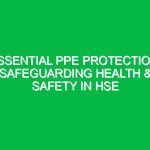Introduction
In the realm of health, safety, and Environment (HSE), the term “PPE” stands for Personal Protective Equipment. Understanding the meaning of PPE is critical as it plays an essential role in safeguarding the health and wellbeing of workers across various sectors. From construction sites to healthcare facilities, the right PPE can mean the difference between Safety and injury. This article explores the significance of PPE, highlights its components, discusses its regulatory framework, and underscores its pivotal role in promoting a safe working environment.
The Meaning of PPE in the HSE Context
Personal Protective Equipment (PPE) encompasses a wide array of protective gear designed to shield individuals from potential Hazards in their work environment. These Hazards can be physical, chemical, biological, or ergonomic in nature. The primary goal of PPE is to minimize exposure to these risks, thereby reducing the likelihood of injury or illness.
PPE comes in various forms, including helmets, gloves, goggles, masks, hearing protection, and full-body suits. Each type of PPE is tailored to protect against specific hazards, making it crucial for employers and employees to conduct thorough risk assessments to determine the appropriate equipment needed for their specific circumstances.
Key Components of PPE
Understanding the various components of PPE can help organizations make informed decisions about protective measures. Below are some key categories of PPE, along with their specific applications:
Head Protection
Helmets and hard hats are essential for protecting against head injuries from falling objects or collisions. For instance, construction workers often wear helmets to safeguard against impacts from above. The effectiveness of head protection relies on proper fit and regular inspections for damage.
Eye and Face Protection
Safety Goggles and face shields protect against chemical splashes, flying debris, and intense light. In laboratories, for example, goggles are mandatory to prevent harmful substances from reaching the eyes. A personal experience from a chemical engineer highlights the importance of wearing Safety goggles; a single splash of acid could have resulted in severe eye damage had she not been wearing protective eyewear.
Respiratory Protection
Respirators and masks are critical in environments where harmful dust, fumes, or aerosols are present. Workers in construction or healthcare frequently use these devices to safeguard their lungs from dangerous particles. The COVID-19 pandemic has further emphasized the importance of respiratory PPE, highlighting the need for masks to prevent virus transmission.
Hand Protection
Gloves are vital in various industries, protecting hands from chemicals, cuts, and thermal injuries. For instance, in food processing, gloves not only protect workers but also maintain hygiene Standards. A notable case involved a food processing plant where the absence of proper hand protection led to multiple injuries, prompting a reassessment of safety protocols.
Foot Protection
Steel-toed boots and other protective footwear are essential in preventing foot injuries from heavy objects. In warehouse settings, for example, employees are required to wear such footwear to mitigate the risk of crush injuries.
Body Protection
Full-body suits, aprons, and vests provide comprehensive protection against various hazards. Chemical plants often require workers to don full-body suits to prevent exposure to toxic substances.
Benefits of Using PPE
The deployment of PPE offers numerous Benefits that extend beyond mere compliance with safety Regulations. Here are some significant advantages:
- Injury Prevention: The primary benefit of PPE is the prevention of injuries and illnesses. By providing appropriate equipment, employers can significantly reduce the likelihood of accidents.
- Legal Compliance: Adhering to PPE regulations helps organizations comply with legal requirements, avoiding potential fines or legal action.
- Employee Confidence: Providing proper PPE fosters a sense of security among employees, enhancing their morale and productivity.
- Reduction of Absenteeism: By preventing injuries and illnesses, PPE contributes to lower absenteeism rates, which in turn leads to improved operational efficiency.
Best Practices for PPE Use
To maximize the effectiveness of PPE, organizations should implement Best Practices that ensure proper usage and Maintenance. Here are some recommendations:
Conduct a Risk Assessment
Before selecting PPE, conduct a thorough risk assessment to identify potential hazards in the workplace. This assessment will guide decisions on what equipment is necessary.
Training and Education
Provide comprehensive Training for employees on the correct use of PPE. This includes how to wear, maintain, and store equipment properly. Regular training sessions can reinforce the importance of PPE use and ensure that all workers understand the risks associated with their jobs.
Regular Inspections
Establish a routine for inspecting PPE for wear and tear. Damaged equipment can compromise safety, so it is essential to replace or repair items as needed.
Involve Employees in the Process
Engage employees in discussions about PPE. Their firsthand experiences can provide valuable insights into the effectiveness and comfort of the equipment being used.
Ensure Proper Fit
PPE must fit correctly to be effective. Employers should provide a range of sizes and styles to accommodate different body types and personal preferences.
Potential Hazards and Safety Considerations
While PPE is crucial for safety, it is not a standalone solution. There are potential hazards associated with improper use of PPE that need to be addressed:
- False Sense of Security: Relying solely on PPE without addressing the root causes of hazards can lead to complacency.
- Improper Use: Wearing PPE incorrectly or not wearing it when required can significantly increase the risk of injury.
- Comfort Issues: Uncomfortable PPE can lead to employees removing it, which defeats its purpose. Ensuring comfort should be a priority.
Regulations and Standards Governing PPE
A variety of regulations and standards govern the use of PPE across different industries. Understanding these legal frameworks is essential for compliance and safety:
Occupational Safety and Health Administration (OSHA)
In the United States, osha sets forth regulations that require employers to provide suitable PPE for their workers. This includes conducting assessments to determine necessary PPE and ensuring that it meets established standards.
American National Standards Institute (ANSI)
ANSI develops standards for various Types of PPE, ensuring that equipment meets safety performance requirements. Compliance with ANSI standards is often seen as a benchmark for safety in the workplace.
European Union Regulations
In Europe, the Personal Protective Equipment Directive mandates that PPE must meet specific safety standards before being placed on the market. This directive ensures that equipment is tested and certified for use.
Conclusion
The meaning of PPE extends far beyond its definition; it is a fundamental component of health, safety, and environmental practices. By understanding the various types of PPE, implementing Best Practices, and adhering to regulatory frameworks, organizations can create safer workplaces for their employees. The importance of PPE in preventing injuries and promoting overall wellbeing cannot be overstated. As we move forward, it is imperative that we prioritize PPE, fostering a culture of safety that protects our most valuable asset—our people. In a world where hazards are ever-present, embracing PPE as an essential safety tool is not just a choice; it is a responsibility.


